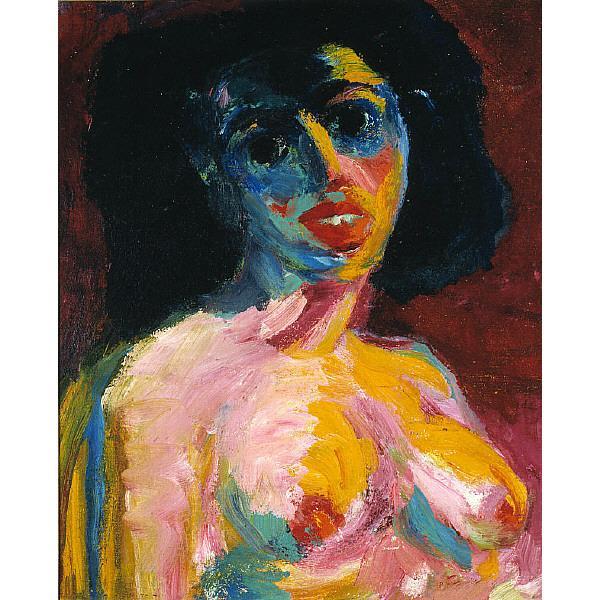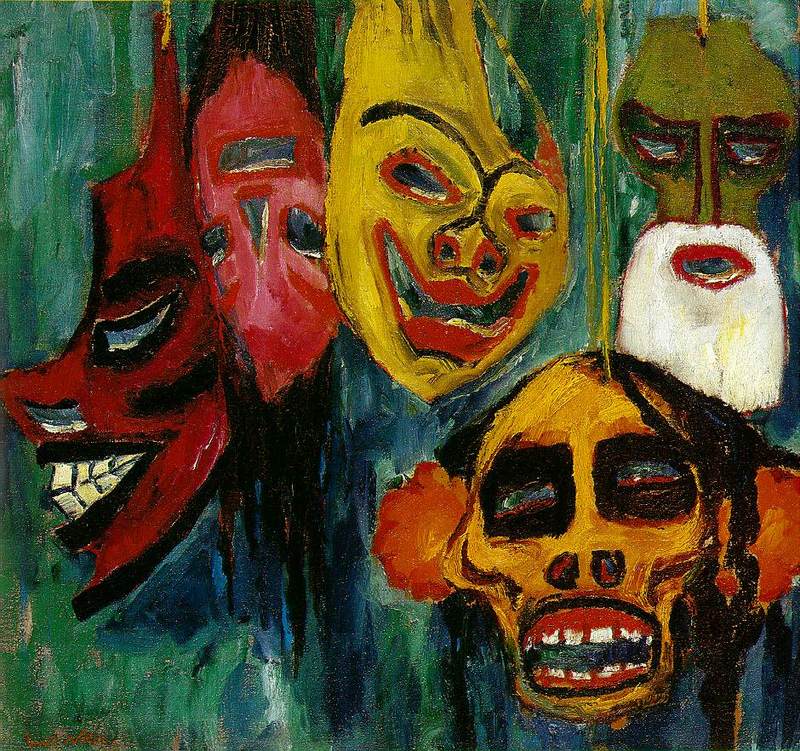Emil Nolde: Woman (In Strong Light)
Emil Nolde's painting Woman (in Strong Light) (Figure 1) is a vibrant painting of an unnamed, unspecified woman. The subject faces the viewer in a traditional three-quarters pose, however Nolde's techniques for rendering this portrait are far from conventional. The artist's thick, painterly strokes and abstract use of color render this woman a dense mass of interacting chromatic fields which highlight her sexual energy and cloud her individuality. Nolde depicts a sense of strong light (hence the title of the piece) through the use of bold yellows highlighting the woman's face on the right side of the image. Nolde's use of color creates sharp contrast with the dense brown and black background to form a sense of three-dimensionality which gives form to the woman depicted. Like many Expressionist artists, Nolde drew from foreign objects found in German ethnographic museums (Note 1). He combines these with the more traditional bust format and expressionist brushwork. The thick, mask-like appearance of the woman's face coupled with her bared chest strip her of individuality and communicate the perceived sexual openness of non-Western women, often the subject of early twentieth century primitivist art.
In 1911, Nolde began working on three separate types of paintings. The first were scenes of Berlin cafes, the second was a group of religious paintings, and last were a group of works referred to as “ethnographic still-lifes” (Note 2). Painted in 1912, Woman (in Strong Light) is most closely related to his work in the third category, although it does not fall directly within any of the three. Nolde's still-lifes were based on objects in Berlin's Ethnological Museum including masks, carved statues, and artifacts or trinkets from colonized peoples (Note 3).Nolde's 1911 painting Masks (Figure 2) serves as a spiritual predecessor for Woman; although not a specific portrait but rather a group of masks (and even a shrunken head!), one sees Nolde's interest in rendering dimensionality through the use of thick brushstrokes and bold, yet subtly varying colors. Nolde's interest in flat, featureless backgrounds like that found in Woman can be seen in this earlier work. In Masks, however,the background is a light greenish-blue and the objects themselves are clearly separated from the scenery rather than blending together to form a continuous space.
In terms of subject matter, Woman (in Strong Light) is inherently quite different from Nolde's ethnographic studies. Presumably painted from a live model, his 1912 piece communicates the presence of an actual person rather than serving solely as a study or exercise in reproducing primitive aesthetics. Nolde's Woman stares directly out at the viewer; her pupils are so large that they could be looking at one no matter from where one is viewing the work. Not only does the woman stare directly at the viewer but she is also bare chested, her breasts accentuated by the cropping of the painting. Her lack of clothing combined with Nolde's use of bright reds highlighting the woman's parted lips convey a direct and unabashed sexuality radiating from his subject. Citizens of colonial powers thought of “primitive” peoples as being more in touch with nature which included an idea of free and unfettered sexuality. Standing in direct contrast to the restrictions Western culture placed on the white male artist's sexuality, “primitive” women were seen as “the very embodiment of sensuality” and displaying a certain kind of “sexual energy (Note 4). Nolde draws from primitivist aesthetics and concepts of female sexuality to create an up-close and personal portrait of a female nude which directly communicates a sense of anonymous and seemingly uncivilized sexuality.
Nolde's explorations into the aesthetics of primitivist masks had a strong influence on the depiction of the subject's face in Woman. Masks typically exaggerate certain features of real faces, twisting and distorting the real into an imagined world. Nolde uses thick brushwork and dense planes of vivid, unrealistic colors in his depiction of the subject's face. The woman's visage becomes muddled and static; her features are frozen in place and in spite of the active brushwork she seems still and fixed. Similarly to the masks he studied at the Ethnological Museum of Berlin, Nolde exaggerates certain features of the woman's face, like her eyes and lips, to magnify the subject's sexual presence and communicate this directly to the viewer. Nolde's sexualization of an anonymous non-western woman stems from a desire to escape from bourgeois Western values into “a redemptive state of sensual innocence” (Note 5).


